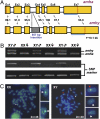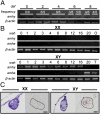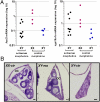A Y-linked anti-Müllerian hormone duplication takes over a critical role in sex determination
- PMID: 22323585
- PMCID: PMC3286941
- DOI: 10.1073/pnas.1018392109
A Y-linked anti-Müllerian hormone duplication takes over a critical role in sex determination
Abstract
Gonadal sex determination in vertebrates generally follows a sequence of genetically programmed events. In what is seemingly becoming a pattern, all confirmed or current candidate "master" sex-determining genes reported in this group, e.g., SRY in eutherian mammals, DMY/dmrt1bY in medaka, DM-W in the African clawed frog, and DMRT1 in chicken encode transcription factors. In contrast, here we show that a male-specific, duplicated copy of the anti-Müllerian hormone (amh) is implicated in testicular development of the teleost fish Patagonian pejerrey (Odontesthes hatcheri). The gene, termed amhy because it is found in a single metacentric/submetacentric chromosome of XY individuals, is expressed much earlier than the autosomal amh (6 d after fertilization vs. 12 wk after fertilization) and is localized to presumptive Sertoli cells of XY males during testicular differentiation. Moreover, amhy knockdown in XY embryos resulted in the up-regulation of foxl2 and cyp19a1a mRNAs and the development of ovaries. These results are evidence of a functional amh duplication in vertebrates and suggest that amhy may be the master sex-determining gene in this species. If confirmed, this would be a unique instance of a hormone-related gene, a member of the TGF-β superfamily, in such a role.
Conflict of interest statement
The authors declare no conflict of interest.
Figures




References
-
- Sinclair AH, et al. A gene from the human sex-determining region encodes a protein with homology to a conserved DNA-binding motif. Nature. 1990;346:240–244. - PubMed
-
- Matsuda M, et al. DMY is a Y-specific DM-domain gene required for male development in the medaka fish. Nature. 2002;417:559–563. - PubMed
-
- Smith CA, et al. The avian Z-linked gene DMRT1 is required for male sex determination in the chicken. Nature. 2009;461:267–271. - PubMed
Publication types
MeSH terms
Substances
LinkOut - more resources
Full Text Sources
Other Literature Sources

